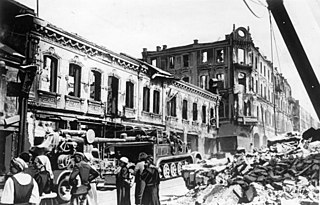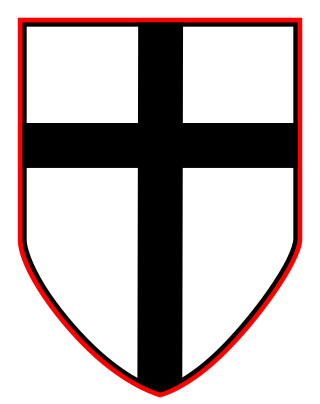
Wolfram Karl Ludwig Moritz Hermann Freiherr von Richthofen was a German World War I flying ace who rose to the rank of Generalfeldmarschall in the Luftwaffe during World War II.

The siege of Sevastopol also known as the defence of Sevastopol or the Battle of Sevastopol was a military engagement that took place on the Eastern Front of the Second World War. The campaign was fought by the Axis powers of Germany and Romania against the Soviet Union for control of Sevastopol, a port in the Crimea on the Black Sea. On 22 June 1941 the Axis invaded the Soviet Union during Operation Barbarossa. Axis land forces reached the Crimea in the autumn of 1941 and overran most of the area. The only objective not in Axis hands was Sevastopol. Several attempts were made to secure the city in October and November 1941. A major attack was planned for late November, but heavy rains delayed it until 17 December 1941. Under the command of Erich von Manstein, Axis forces were unable to capture Sevastopol during this first operation. Soviet forces launched an amphibious landing on the Crimean peninsula at Kerch in December 1941 to relieve the siege and force the Axis to divert forces to defend their gains. The operation saved Sevastopol for the time being, but the bridgehead in the eastern Crimea was eliminated in May 1942.

Case Blue was the German Armed Forces' plan for the 1942 strategic summer offensive in southern Russia between 28 June and 24 November 1942, during World War II. The objective was to capture the oil fields of Baku, Grozny and Maikop for two purposes: to enable the Germans to re-supply their low fuel stock and also to deny their use to the Soviet Union, thereby bringing about the complete collapse of the Soviet war effort.

The Battle of Białystok–Minsk was a German strategic operation conducted by the Wehrmacht's Army Group Centre under Field Marshal Fedor von Bock during the penetration of the Soviet border region in the opening stage of Operation Barbarossa, lasting from 22 June to 9 July 1941.

The Byelorussian Military District was a military district of the Soviet Armed Forces. Originally formed just before World War I as the Minsk Military District out of the remnants of the Vilno Military District and the Warsaw Military District, it was headed by the Russian General Eugen Alexander Ernst Rausch von Traubenberg.

Sturzkampfgeschwader 2 Immelmann was a Luftwaffe dive bomber-wing of World War II. It was named after the World War I aviator Max Immelmann. It served until its dissolution in October 1943. The wing operated the Junkers Ju 87 Stuka exclusively.

The Odesa Military District was a military administrative division of the Armed Forces of Ukraine. This district consisted of Moldavia and five Ukrainian oblasts of Odesa, Mykolaiv, Kherson, Crimea and Zaporizhzhia. In 1998 most of its territory was transformed into the Southern Operational Command.

The 10th Army of the Soviet Union's Red Army was a field army active from 1939 to 1944.

Hubertus Hitschhold was a German general and ground-attack pilot during World War II. He was a recipient of the Knight's Cross of the Iron Cross with Oak Leaves of Nazi Germany.

The 12th Mechanized Corps was a formation in the Soviet Red Army during the Second World War.

Sturzkampfgeschwader 77 (StG 77) was a Luftwaffe dive bomber wing during World War II. From the outbreak of war StG 77 distinguished itself in every Wehrmacht major operation until the Battle of Stalingrad in 1942. If the claims made by StG 77 are accurate, it inflicted more damage to enemy ground forces than any other wing. It operated the Junkers Ju 87 dive-bomber exclusively in the combat role. The Dornier Do 17 and Messerschmitt Bf 110 were both used in the air reconnaissance role.

This is the order of battle for Operation Barbarossa, the German invasion of the Soviet Union during World War II. It was fought between the German-led Axis Forces and the Soviet Forces. The operation started on June 22, 1941, and ended on December 5, 1941, after Operation Typhoon.

The 7th Mechanized Corps was a mechanized corps of the Red Army, formed three times. The corps was first formed in 1934 in the Leningrad Military District and was converted into the 10th Tank Corps in 1938. The corps was reformed in the summer of 1940 in the Moscow Military District and fought in the Battle of Smolensk, after which its headquarters became part of Group Yartsevo's headquarters. The corps was formed a third time in August and September 1943. The third formation fought in the Dnieper–Carpathian Offensive, Uman–Botoșani Offensive, Second Jassy–Kishinev Offensive, Battle of Debrecen, Budapest Offensive, Bratislava–Brno Offensive, Prague Offensive, and the Soviet invasion of Manchuria. Postwar, the corps' third formation became a division and was disbanded in 1957.
The 11th Mechanized Corps was a mechanized corps of the Red Army, formed twice. The corps was first formed as one of the original two Red Army mechanized corps from the 11th Rifle Division in Leningrad. In 1934 it was transferred to the Transbaikal Military District and in 1938 became the 20th Tank Corps. The corps was reformed in March 1941 in western Belarus. After the German invasion of the Soviet Union, the understrength corps was destroyed in the Battle of Białystok–Minsk.
The 3rd Cavalry Corps was a corps of the Soviet Red Army.
The 5th Rifle Corps was a corps of the Soviet Union's Red Army, formed twice.
The 11th Rifle Corps was a corps of the Red Army, formed twice.
The 2nd Cavalry Corps were a corps of the Red Army, formed twice. Originally formed in 1922, the corps served in Ukraine during the Interwar period and fought in the Soviet invasion of Poland.
The 4th Cavalry Corps was a cavalry corps of the Soviet Red Army, formed three times.

The Kharkov Military District was a military district of the Russian Empire, the Russian Soviet Federative Socialist Republic, and the Soviet Union. Throughout its history, the district headquarters was located in the city of Kharkov in northeastern Ukraine.













